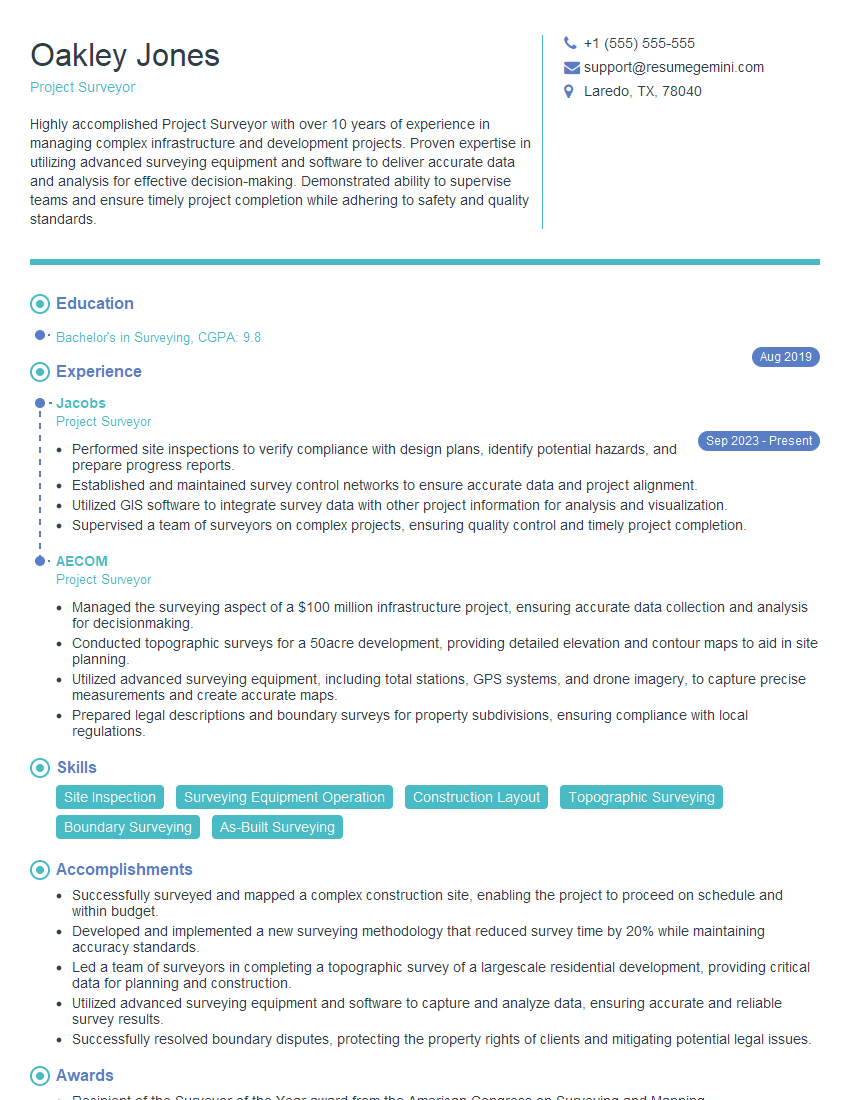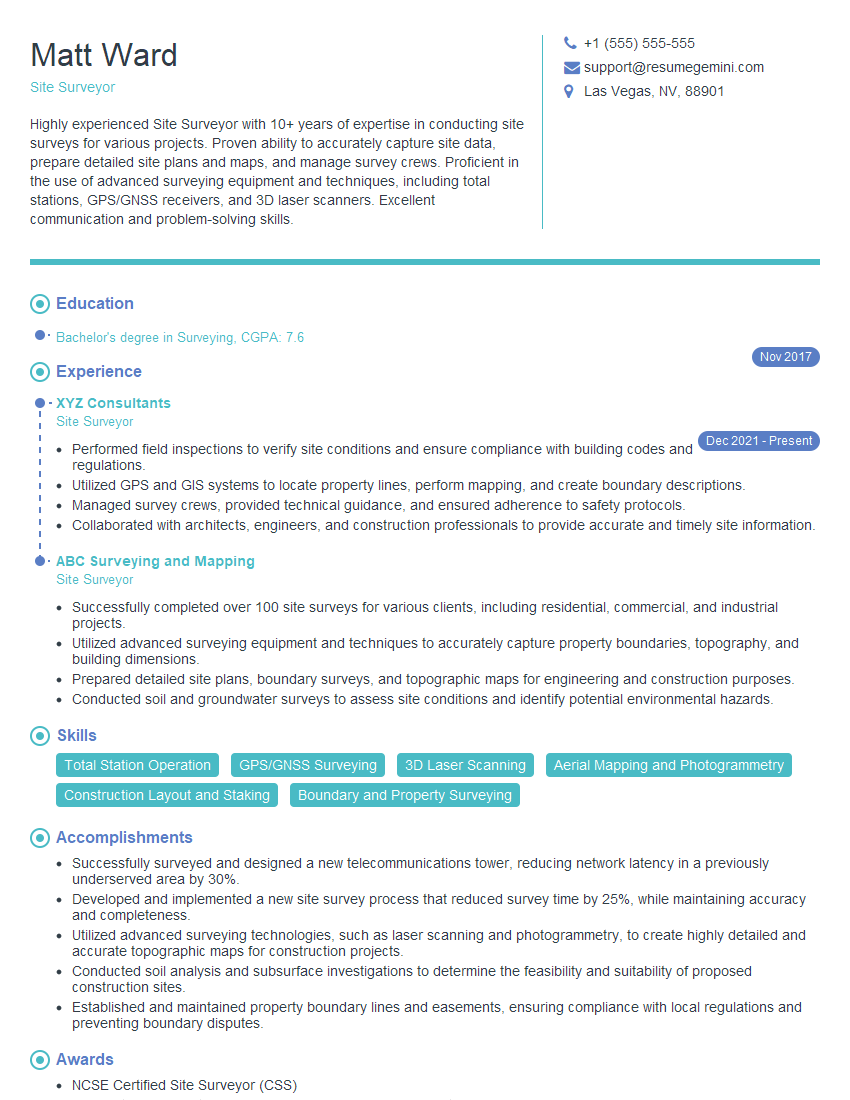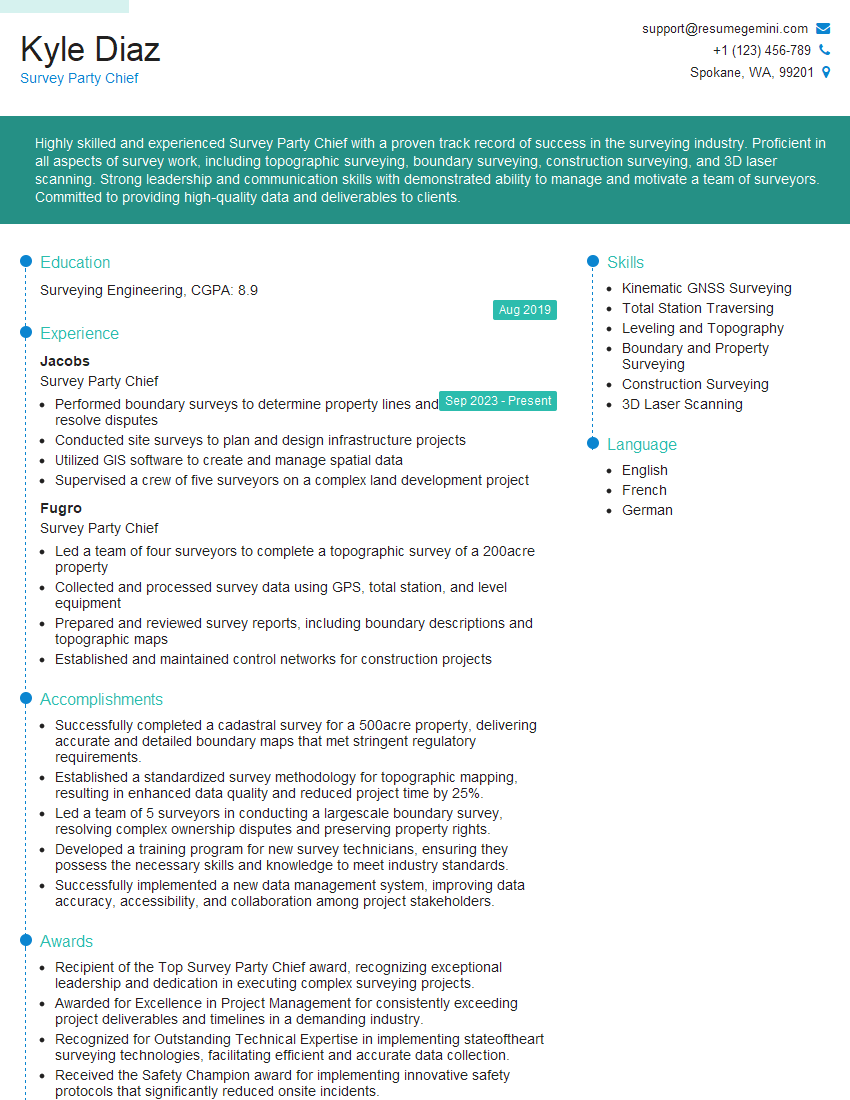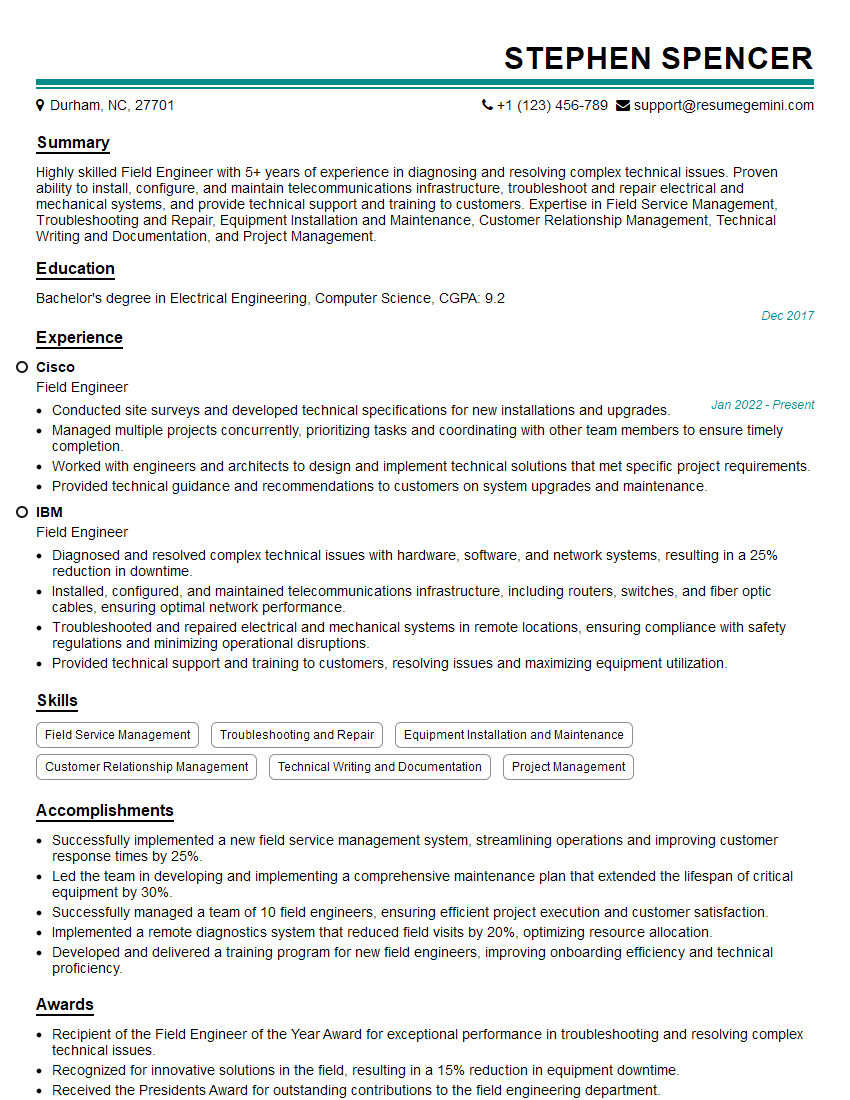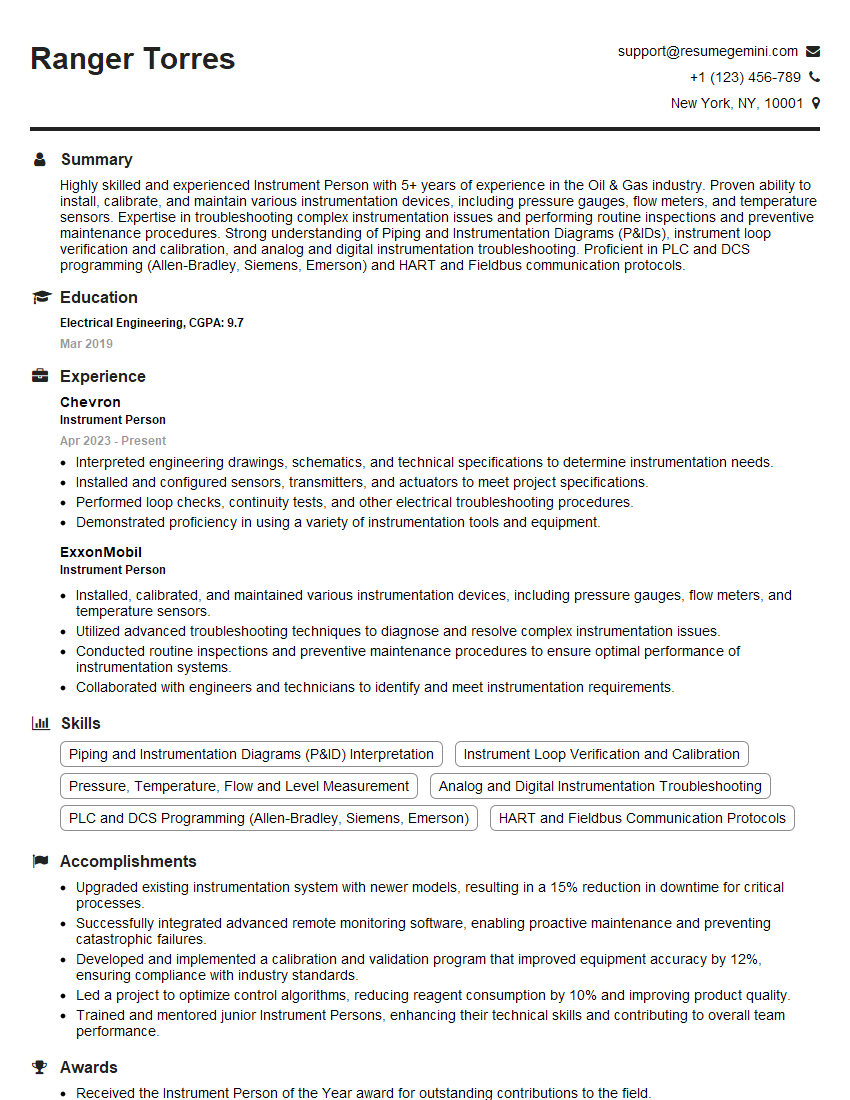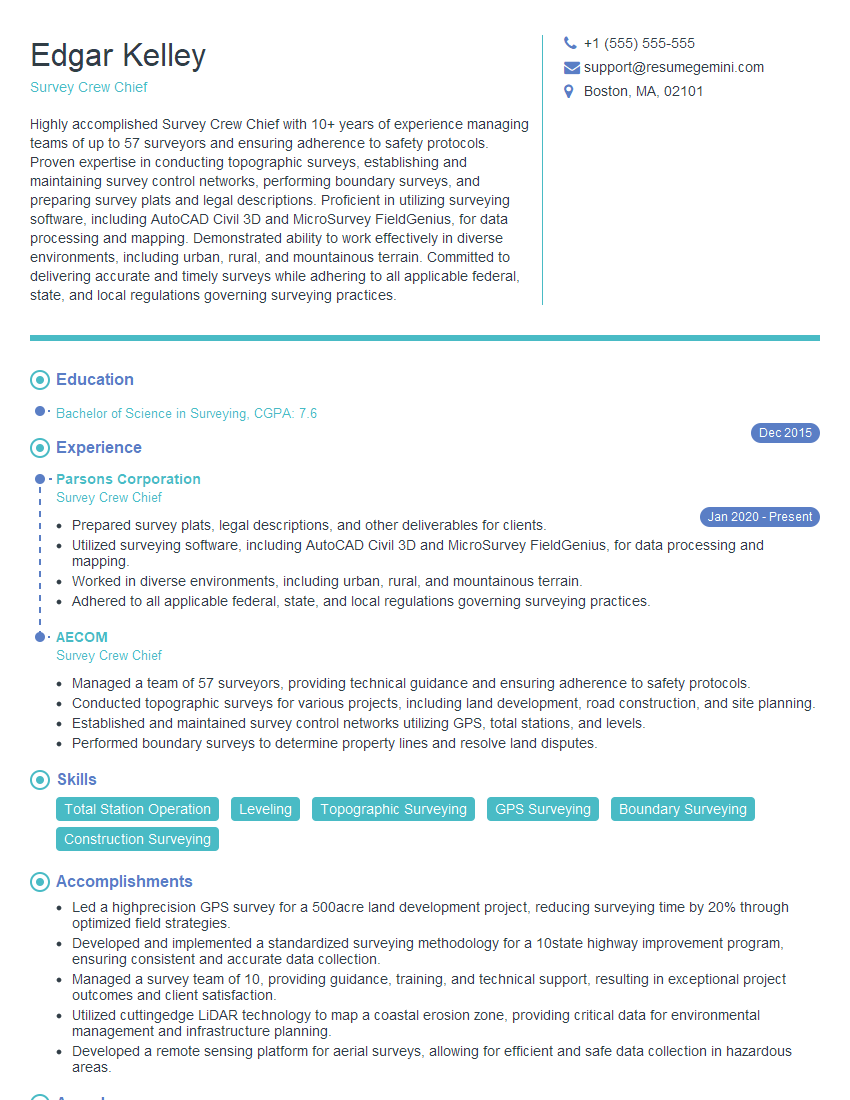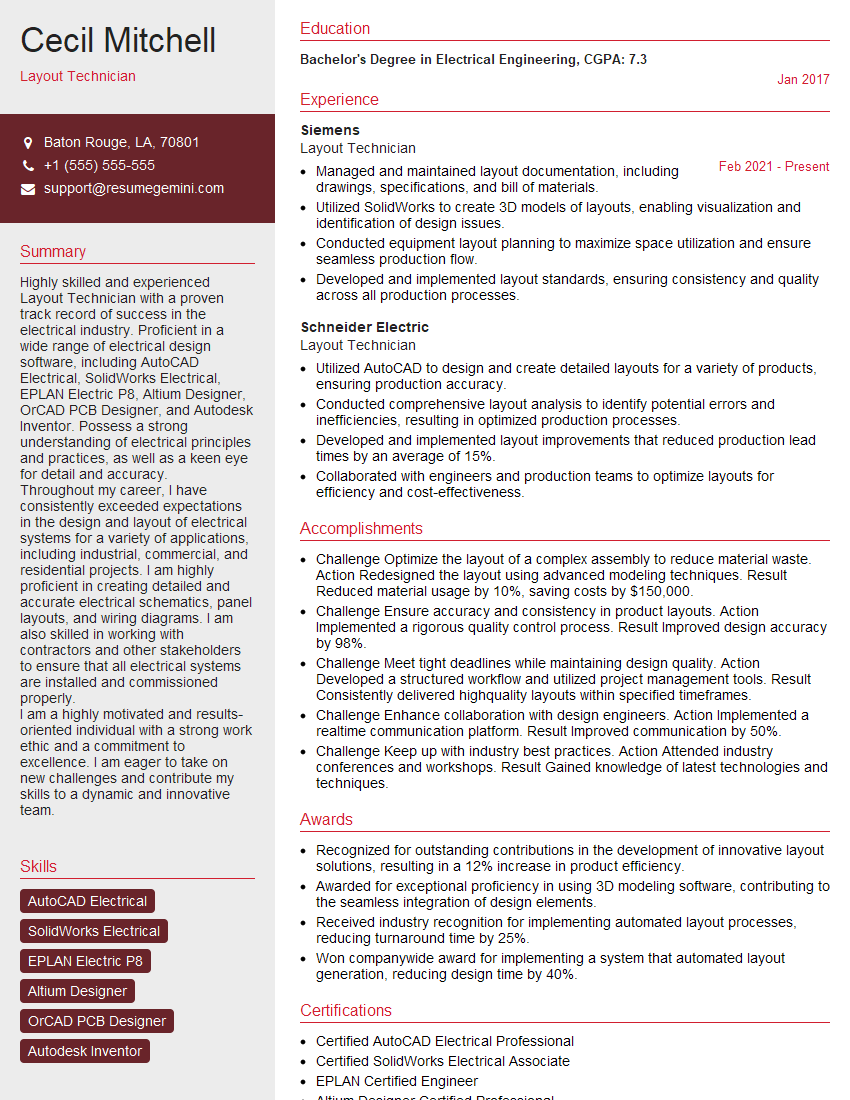Cracking a skill-specific interview, like one for Experience in construction layout and as-built surveys, requires understanding the nuances of the role. In this blog, we present the questions you’re most likely to encounter, along with insights into how to answer them effectively. Let’s ensure you’re ready to make a strong impression.
Questions Asked in Experience in construction layout and as-built surveys Interview
Q 1. Explain the difference between construction layout and as-built surveying.
Construction layout and as-built surveying are two crucial phases in construction, both involving precise measurements and documentation, but serving distinct purposes. Construction layout is the process of transferring design plans from paper to the actual construction site. Think of it as creating the blueprint’s physical manifestation on the ground. This involves establishing benchmarks, setting out building lines, and marking locations for foundations, walls, and other elements. It ensures that the construction proceeds according to the design. As-built surveying, on the other hand, is a post-construction process of documenting the final physical reality of the completed structure. It meticulously records the as-built dimensions, locations, and details of all the constructed elements, often deviating slightly from the original design. This acts as a permanent record for future maintenance, renovations, or legal purposes. Essentially, layout prepares the ground for construction, while as-built surveying documents the final outcome.
For example, in constructing a building, layout would involve marking the foundation lines and column positions according to the architectural and structural plans. As-built surveying, after construction, would accurately record the actual location and dimensions of these elements, which might differ slightly from the initial layout due to minor on-site adjustments during construction.
Q 2. Describe your experience with various surveying instruments (e.g., total stations, GPS, levels).
My experience encompasses a wide range of surveying instruments. I’m proficient in using total stations for precise angle and distance measurements, essential for setting out points and determining coordinates with high accuracy. I’ve extensively used GPS (Global Positioning System) receivers, particularly RTK (Real-Time Kinematic) systems, for establishing control points and performing large-scale surveys, leveraging their capabilities for high-accuracy positioning even over longer distances. Finally, I’m experienced with levels for determining elevations and establishing grade lines, crucial for earthworks and ensuring proper drainage. I understand the limitations and strengths of each instrument and choose them strategically based on the project’s requirements and available resources. For instance, on smaller projects where a highly detailed local control is needed, the total station might be preferred, whereas on larger infrastructure projects, GPS might be more efficient for establishing control networks.
Q 3. How do you ensure accuracy in construction layout?
Ensuring accuracy in construction layout is paramount and involves a multifaceted approach. Firstly, it begins with meticulously verifying the design plans, identifying potential conflicts or ambiguities before starting fieldwork. Then, establishing a robust control network using accurate baselines and benchmarks is crucial. This serves as a reference for all subsequent measurements. We employ techniques like double-checking measurements, using redundancy in our measurements, and employing multiple instruments where appropriate. For example, checking horizontal alignment using both total station and GPS measurements. Regular calibration of instruments is also essential. Furthermore, maintaining detailed field notes and incorporating quality control checks at each step are critical to minimizing errors. A common practice is to independently verify measurements with different techniques and personnel, further enhancing confidence in the accuracy of the layout.
Q 4. What are common challenges encountered during construction layout, and how have you overcome them?
Common challenges in construction layout include unclear or conflicting design drawings, site obstructions hindering access to measurement points, unstable ground conditions affecting accuracy, and unforeseen underground utilities. I’ve tackled these by collaborating closely with designers and engineers to clarify ambiguities in drawings and by creatively adapting measurement techniques to overcome site constraints. For instance, when encountering unstable ground, I might use a more stable reference point or employ specialized surveying techniques. For buried utilities, we use non-destructive methods like ground-penetrating radar to locate them and avoid damaging them. Efficient communication and proactive problem-solving are keys to mitigating these challenges and ensuring the project stays on schedule.
Q 5. Explain your experience with coordinate geometry and its application in construction layout.
Coordinate geometry is fundamental to construction layout. I utilize it extensively to transform design coordinates into real-world positions on site. This involves transforming 2D or 3D coordinates from the design plan into real-world coordinates using known control points. For instance, using transformations to account for any differences between the design coordinate system and the site coordinate system. This enables the precise location of elements, such as columns and walls, using the total station or GPS equipment guided by these calculated coordinates. I’m proficient in various coordinate transformation techniques and use software to perform these calculations quickly and accurately, reducing the risk of errors. Software calculation also helps in complex situations where many coordinate conversions and computations are required.
Q 6. How do you handle discrepancies between design plans and field conditions during layout?
Discrepancies between design plans and field conditions are common. My approach involves thoroughly documenting all discrepancies, which might include clash detection, conflicting dimensions, or differing levels. I then collaborate with the design team to resolve these issues through careful analysis, measurement verification, and potentially revised design drawings or modifications on site. Clear documentation, involving photographs, sketches and detailed descriptions, is vital in communicating these discrepancies to the relevant stakeholders. Detailed records are also kept of any decisions made during the resolution process. The objective is to find solutions that balance adherence to the original design intent while accommodating realistic field conditions.
Q 7. Describe your proficiency in using CAD software for construction layout and as-built drawings.
I’m highly proficient in using CAD software like AutoCAD and Civil 3D for creating construction layout drawings and as-built drawings. I can generate precise plans, sections, and details, import and export data from surveying instruments, and coordinate geometry software, and annotate drawings with detailed information regarding the measurements and coordinates. I leverage CAD’s capabilities for visualization, ensuring a clear understanding of the layout before initiating construction and for creating accurate and comprehensive as-built drawings once construction is completed. This ensures consistency and accuracy throughout the entire construction process. I can also use the software to perform complex calculations and generate reports that support the project documentation and aid in future referencing.
Q 8. How do you manage and maintain field survey data?
Managing and maintaining field survey data requires a systematic approach. Think of it like a meticulously organized library for your project. It starts with a clear naming convention for all files – project name, date, survey type (e.g., ‘Project Alpha_2024-10-26_Topographic Survey.dxf’). This ensures easy retrieval.
Next, I use a robust cloud-based storage system, like Autodesk BIM 360 or similar, to store all data. This allows for easy access and collaboration amongst team members. Data is categorized into folders by survey type, date, and instrument used. Regular backups to a separate, secure server are essential to prevent data loss.
Finally, data integrity is paramount. I implement regular data checks for inconsistencies and errors. This can involve comparing data from multiple surveys, visual inspections using GIS software, and even field verification. A detailed log is maintained, recording any changes or corrections made to the data.
Q 9. What quality control measures do you implement in your work?
Quality control is woven into every stage of my work. It’s not an afterthought; it’s an integral part of the process. Think of it as building a house with rigorous inspections at each stage. My QC measures include:
- Instrument Calibration: Regular calibration of total stations, GPS receivers, and levels ensures accuracy. Calibration certificates are always kept on file.
- Redundant Measurements: I always take redundant measurements – multiple readings of the same point. This helps identify and eliminate outliers caused by mistakes or environmental factors.
- Independent Checks: Whenever possible, another surveyor will independently check my work, especially for critical points. This cross-verification minimizes errors.
- Data Validation: Before using any data, I run it through quality control software to check for inconsistencies and errors. This flags any data points that fall outside acceptable tolerances.
- Documentation: All QC procedures are documented and regularly reviewed. This allows for continuous improvement and helps us identify areas for improvement.
Q 10. Explain your understanding of construction tolerances and their importance.
Construction tolerances are the permissible variations from the design plans. Think of them as the acceptable margin of error. They’re crucial because perfect accuracy is virtually impossible in construction. Tolerances are specified for different aspects of a project – dimensions, elevations, angles, etc. These tolerances are defined in the project specifications and blueprints, and they vary depending on the type of work and the material used.
For example, a tolerance of ±5mm might be acceptable for wall thickness in a residential project but unacceptable for precision machinery installation in an industrial plant. Understanding and adhering to these tolerances ensures that the final structure is functional, safe, and meets the design intent. Ignoring them can lead to costly rework, structural problems, or even project failure.
Q 11. How do you communicate effectively with construction crews regarding layout information?
Effective communication is key. I use a multi-pronged approach that prioritizes clarity and accessibility.
- Clear Markings: I use clear, concise markings on the site – stakes, paint, and labels – to mark out critical points. I avoid ambiguity.
- Simple Drawings: I provide the construction crew with simplified, easy-to-understand drawings, often hand-drawn sketches supplementing the digital plans. This facilitates quick understanding.
- On-site Briefings: I conduct regular on-site briefings to explain the layout, highlighting key points and potential challenges. This direct interaction ensures that everyone is on the same page.
- Digital Tools: I use digital tools like tablets with cloud-based plans, to provide up-to-date and easily accessible information. This ensures any changes or updates can be quickly disseminated.
- Open Communication Channels: I encourage open communication. I make myself available to answer questions and address concerns promptly.
Q 12. Describe your experience with different types of construction projects (e.g., residential, commercial, industrial).
My experience spans various construction sectors. In residential projects, I’ve focused on accurate lot layout and foundation placement, emphasizing precise measurements to ensure the house sits correctly on its foundation. In commercial projects, managing complex layouts with intricate coordination among different trades is crucial – accurate dimensions for structural components and MEP systems are critical.
Industrial projects require a high level of precision. Tolerance requirements are often stricter, and accuracy is paramount for machinery placement and other critical elements. I’ve worked on projects involving large-scale industrial plants, where even minor inaccuracies could have significant consequences. Each project type requires a unique approach to data management and precision based on its complexity and tolerance requirements.
Q 13. How do you prepare as-built drawings, and what information do they typically include?
As-built drawings are a record of what was actually constructed, as opposed to the design plans. Think of it as the ‘after’ picture that documents the final reality. They are essential for maintenance, future renovations, and legal compliance.
Preparing as-built drawings involves systematically recording all deviations from the original plans. This includes detailed measurements of completed work, noting any changes or modifications made during construction. Typically, as-built drawings include:
- Dimensions: Accurate measurements of all key elements.
- Locations: Precise locations of all utilities, equipment, and structural elements.
- Modifications: Documentation of any changes from the original design.
- Materials: A record of the materials actually used.
- Notes: Any relevant observations or comments.
Q 14. What software or tools do you use to create as-built drawings?
I utilize a range of software and tools for creating as-built drawings. My go-to software is AutoCAD, which is industry standard for its versatility and precision. I also use Civil 3D for projects involving significant earthworks or complex terrain. For point cloud processing and analysis, I use software like Recap Pro. In addition, I utilize GPS data processing software for integrating GPS data into my drawings.
Alongside software, field tools like total stations, GPS receivers, and laser scanners play a crucial role in data acquisition. The choice of tools depends on the project’s scale, complexity, and the level of precision required.
Q 15. How do you ensure the accuracy of as-built drawings?
Ensuring accuracy in as-built drawings is paramount. It involves a multi-pronged approach that begins even before construction starts. We start with meticulous field verification of the initial design drawings against the actual site conditions. This includes checking for discrepancies between the design and existing features, utilities, and topography.
During construction, regular surveys are crucial. I employ various methods like total station surveys, GPS surveying, and laser scanning to capture the as-built data. Each measurement is meticulously recorded, checked, and double-checked using independent methods whenever possible to minimize errors. For instance, we might use two different total stations to check each other’s measurements for critical points.
After data collection, rigorous quality control is essential. This includes data processing, editing, and error detection using specialized software. We look for inconsistencies, outliers, and discrepancies that might indicate errors in the field measurements. Finally, the drawings are reviewed by a second surveyor before final approval. This layered approach ensures a high degree of accuracy and minimizes the chances of errors appearing in the final as-built drawings. A final site walk-through confirms the accuracy of the final product.
Career Expert Tips:
- Ace those interviews! Prepare effectively by reviewing the Top 50 Most Common Interview Questions on ResumeGemini.
- Navigate your job search with confidence! Explore a wide range of Career Tips on ResumeGemini. Learn about common challenges and recommendations to overcome them.
- Craft the perfect resume! Master the Art of Resume Writing with ResumeGemini’s guide. Showcase your unique qualifications and achievements effectively.
- Don’t miss out on holiday savings! Build your dream resume with ResumeGemini’s ATS optimized templates.
Q 16. How do you handle revisions and updates to as-built drawings?
Handling revisions and updates to as-built drawings requires a systematic and documented process. Any changes, no matter how minor, are recorded using a revision control system. This typically involves assigning revision numbers to each update, documenting the date, the nature of the change, and the person responsible.
We utilize revision clouds or other visual cues on the drawings themselves to clearly highlight the modified areas. This makes it easy to identify what’s changed from one revision to the next. The revision history is meticulously maintained to create a complete audit trail. We employ software like AutoCAD or Revit to manage revisions effectively, allowing for easy comparison between versions and rollback capabilities if needed.
For example, if a utility line needs to be relocated, I would update the as-built drawing to reflect this, including the new location and relevant details. The revision would then be clearly marked, and a note added detailing the reason for the change. This documented approach ensures transparency and allows for easy tracking of changes over the project’s lifecycle.
Q 17. Explain your experience with laser scanning or 3D modeling in construction.
Laser scanning and 3D modeling have revolutionized the accuracy and efficiency of construction layout and as-built surveys. I have extensive experience using laser scanners to capture highly accurate point cloud data of existing structures and sites. This data can be used to create precise 3D models, which provide a comprehensive representation of the site’s geometry.
These models are invaluable for various applications. For example, during construction layout, the 3D model helps in accurately positioning new structures and components relative to the existing environment. For as-built surveys, the point cloud data can be compared against the design model to identify discrepancies and generate highly detailed as-built drawings automatically.
I have personally used Leica and Faro laser scanners and have worked with software such as Autodesk Recap and Cyclone to process point cloud data and generate 3D models. In one project, using laser scanning significantly reduced the time needed for as-built surveying by at least 50% compared to traditional methods.
Q 18. How do you manage and mitigate risks associated with construction layout?
Managing and mitigating risks in construction layout requires a proactive and systematic approach. One major risk is inaccurate measurements, which can lead to costly errors during construction. To mitigate this, I employ robust quality control measures at every stage, including multiple checks of measurements, independent verification by different team members, and utilization of redundant technologies like GPS and total stations in tandem.
Another risk involves conflicts between design and existing site conditions. This is addressed through detailed site surveys and careful coordination with the design team before construction begins. Unexpected underground utilities present another significant risk. We use ground-penetrating radar and utility locating services to identify and mark such utilities before excavation to prevent damage and avoid delays.
Clear communication and collaboration among all stakeholders, from designers and contractors to subcontractors, is crucial for risk reduction. Regular meetings, detailed drawings, and comprehensive documentation are essential to ensure everyone is on the same page. Following established safety protocols is also vital, ensuring the safety of personnel and equipment on site.
Q 19. Describe your understanding of legal and safety regulations related to surveying.
My understanding of legal and safety regulations related to surveying is comprehensive. I am thoroughly familiar with local, state, and national regulations governing land surveying, including licensing requirements, professional standards of practice, and legal liabilities associated with surveying errors. I adhere to the highest ethical standards and prioritize safety in all surveying operations.
Safety regulations are strictly followed, including the use of appropriate personal protective equipment (PPE), such as safety helmets, high-visibility clothing, and safety footwear. Awareness of and compliance with OSHA (Occupational Safety and Health Administration) guidelines and any site-specific safety plans are paramount. I understand the importance of accurate record-keeping to comply with legal requirements, ensuring that all survey data and related documentation are properly stored and readily accessible.
Understanding the legal ramifications of incorrect surveying is crucial. Incorrect measurements can lead to legal disputes, property line conflicts, and potentially costly litigation. To mitigate this, I maintain meticulous records and conduct thorough quality checks to ensure the accuracy and reliability of my work.
Q 20. How do you ensure the timely completion of layout and as-built surveying tasks?
Timely completion of layout and as-built surveying tasks is achieved through meticulous planning, efficient resource allocation, and effective team management. Prior to commencing work, I develop a detailed project schedule that outlines all tasks, their durations, and dependencies. This schedule is regularly reviewed and updated to account for any unforeseen delays or changes in scope.
Efficient resource allocation is key. This includes selecting the right equipment and personnel for the job and optimizing the workflow to minimize downtime. I utilize technology to streamline processes, such as using digital data collection devices, cloud-based data storage, and automated data processing software. Communication is paramount – frequent updates with the project team, subcontractors, and clients ensure everyone is informed of progress and any potential issues are addressed proactively.
For example, in a recent project, using a laser scanner instead of traditional methods significantly reduced the time required for as-built surveying, enabling timely project completion and preventing delays to subsequent phases. Proactive problem-solving and contingency planning also play a significant role in ensuring that the work stays on schedule.
Q 21. What is your experience with BIM (Building Information Modeling) and its integration with layout and as-built surveys?
BIM (Building Information Modeling) has greatly enhanced the integration of layout and as-built surveys. I have significant experience integrating BIM workflows into my practice. The use of BIM allows for a more coordinated and efficient approach to construction projects. The digital model serves as a central source of truth, eliminating discrepancies between design and construction.
During the layout phase, I utilize the BIM model to accurately position elements on-site. For example, I can extract coordinates from the model and use them to guide the placement of structural elements, ensuring precision and minimizing errors. During the as-built phase, field measurements are linked back to the BIM model, updating it to reflect the actual construction.
This integration allows for seamless comparison between the design and as-built models, enabling quick identification of discrepancies. In some cases, I can directly extract as-built drawings from the updated BIM model, significantly streamlining the drawing creation process. This integration not only improves accuracy and efficiency but also facilitates better communication and collaboration among all project stakeholders.
Q 22. Describe a challenging construction layout problem you faced and how you solved it.
One of the most challenging layout problems I encountered involved a complex underground utility network during the construction of a high-rise building. The design showed utilities in locations that differed significantly from the as-built records available. Simply laying out the building based on the design risked damaging these unseen utilities, causing costly delays and potential safety hazards.
To solve this, we implemented a multi-pronged approach. First, we conducted a thorough ground penetrating radar (GPR) survey to pinpoint the exact locations of existing utilities. This provided a much more accurate picture than the outdated records. Second, we used a robotic total station to create a highly accurate 3D model of the existing utility network. Third, we used this model to coordinate the building layout, avoiding conflicts. This involved adjusting the building’s foundation placement slightly and carefully routing the new utilities around the existing ones. Finally, we implemented a stringent quality control process, including daily checks and close collaboration with the utility companies, to ensure the accuracy of the layout throughout the construction.
This approach successfully avoided damage to existing utilities, prevented costly rework, and ensured the safety of the construction crew. It highlighted the importance of integrating advanced surveying techniques with careful planning and collaboration.
Q 23. How do you interpret and apply surveying data from various sources?
Interpreting and applying surveying data requires a systematic approach that considers data source reliability and accuracy. I typically begin by reviewing the metadata associated with each data set to understand its origin, collection methods, accuracy, and coordinate system. For example, data from a total station survey will generally be more accurate than data from a less precise GPS survey. I then use appropriate software to process and transform the data to a common coordinate system and datum.
Data inconsistencies are often addressed through a process of reconciliation. This may involve comparing multiple data sources, identifying outliers, and determining the most likely true values. If there are significant discrepancies, I’ll investigate the source of the error, which could range from instrument malfunction to human error in data entry. Advanced techniques like least squares adjustment can be used to improve the overall accuracy by finding the best fit through conflicting points.
Finally, the interpreted data is applied in the construction layout. This might involve generating digital terrain models (DTMs), setting out control points, or creating detailed plans for construction elements. Throughout this process, rigorous quality control is essential to ensure the accuracy and reliability of the results.
Q 24. What is your experience with different types of survey control?
My experience encompasses various survey control methods, including:
- Geodetic Control: This involves establishing a network of highly accurate control points, often using GPS or precise leveling, that serve as a reference for all subsequent surveys. This is crucial for large-scale projects ensuring all measurements tie back to a known global or national coordinate system.
- Local Control: For smaller projects, I’ve established local control networks using total stations. This involves setting out a network of points within the project site, which are accurately measured and related to each other, creating a local reference framework.
- Construction Control: This involves setting out precise points for the actual construction activities. This often uses total stations or GPS to locate and define the precise positions of building corners, foundations, and other elements.
The choice of control method depends on the project’s scale, complexity, and required accuracy. Each method presents unique challenges and requires careful planning and execution to ensure the accuracy and reliability of the results.
Q 25. Explain your understanding of error propagation and its impact on accuracy.
Error propagation refers to the accumulation of errors throughout a survey process. Each measurement inherently has some degree of error, and these errors combine and propagate through calculations, leading to a larger overall error in the final result. Understanding error propagation is critical for evaluating the accuracy of surveying work and for planning mitigation strategies.
For example, if we’re determining the area of a lot by measuring its sides, a small error in measuring each side will result in a larger error in the calculated area. This is because the area calculation involves multiplying the side lengths, amplifying the initial errors. Similarly, errors in leveling can accumulate during long leveling runs, leading to significant vertical inaccuracies.
To mitigate the impact of error propagation, it’s crucial to use precise equipment, employ appropriate surveying techniques (redundant measurements, least squares adjustment), and thoroughly document all measurements and calculations. A well-planned survey design that minimizes the number of measurements and employs robust error-checking procedures is vital for obtaining accurate results.
Q 26. How do you manage conflicting information from various sources during as-built surveying?
Managing conflicting information in as-built surveying requires careful analysis and investigation. I approach this using a structured process:
- Data Verification: I start by verifying the source and reliability of each conflicting data point. This might involve contacting the original surveyors or reviewing project records. Understanding the methods used to obtain each data set is crucial.
- Field Verification: Whenever possible, I conduct field checks to physically verify measurements and resolve discrepancies. This could involve re-measuring key locations or comparing survey data to existing physical features.
- Data Reconciliation: Based on the verification results, I analyze the conflicting data to determine the most likely true values. This often involves assessing the precision of different data sources and using statistical methods to resolve discrepancies.
- Documentation: I meticulously document all steps taken during the conflict resolution process, including the original conflicting data, the methods used to resolve them, and the final adopted values. This documentation is essential for transparency and accountability.
The goal is to produce an as-built survey that accurately reflects the constructed reality, even when dealing with conflicting information. Sometimes, the ‘truth’ requires professional judgement and a clear understanding of potential error sources.
Q 27. What is your experience with using robotic total stations?
I have extensive experience using robotic total stations, which have significantly improved efficiency and accuracy in construction layout and as-built surveying. Their automated features, such as automatic target recognition and remote operation, streamline the surveying process. I am proficient in using robotic total stations for tasks such as:
- Setting out points: Precisely locating points for foundations, walls, and other construction elements.
- As-built surveying: Accurately measuring and documenting the completed construction.
- Volume calculations: Determining earthworks quantities through the creation of 3D models.
The ability to work remotely reduces the time required for measurements, increases safety by minimizing the need for personnel to be near hazardous areas, and provides the ability to survey in environments that are inaccessible or dangerous for traditional methods.
Q 28. Describe your understanding of different coordinate systems used in construction surveying.
Construction surveying utilizes different coordinate systems depending on the project’s scale and location. Common systems include:
- State Plane Coordinate System (SPCS): A system designed for use within a specific state, using different projections and units depending on the region. It allows for mapping and surveying at a local level.
- Universal Transverse Mercator (UTM): A global coordinate system that divides the Earth into zones, using a transverse Mercator projection. It’s often used for large-scale projects spanning multiple states or countries.
- Geographic Coordinate System (GCS): Uses latitude and longitude to define positions on the Earth’s surface. It’s used for global positioning and is essential for relating local coordinate systems to the global geodetic system.
- Local Coordinate Systems: These are arbitrary systems established locally for specific projects. They are often chosen for simplicity and convenience but must be carefully related to a known datum (a reference point) such as the NAD83 or WGS84 datum.
Understanding these different coordinate systems is critical for data transformation and ensuring compatibility between various data sources. I always ensure correct coordinate system use to maintain the integrity of the survey data throughout the project lifecycle.
Key Topics to Learn for Experience in Construction Layout and As-Built Surveys Interview
- Understanding Construction Drawings: Mastering the interpretation of architectural, structural, and MEP drawings – including symbols, scales, and specifications – is crucial. Practice identifying key features and potential discrepancies.
- Layout Techniques: Become proficient in various layout methods, including using total stations, GPS, and traditional surveying tools. Understand the importance of accuracy and precision in establishing control points and verifying measurements.
- As-Built Surveying Procedures: Learn the process of documenting completed construction work, including accurate measurements, detailed notes, and the use of specialized software for data collection and processing. Understand the importance of documenting deviations from the original plans.
- Coordinate Systems and Data Management: Gain a solid understanding of coordinate systems (e.g., state plane coordinates, UTM) and different data formats used in construction surveying. Practice organizing and managing large datasets efficiently.
- Quality Control and Error Detection: Develop skills in identifying and resolving discrepancies between as-built surveys and original plans. Understand common sources of error and implement effective quality control measures.
- Software Proficiency: Familiarize yourself with industry-standard software used for surveying and CAD (e.g., AutoCAD Civil 3D, Revit). Practice using these tools to create and manage construction layouts and as-built drawings.
- Problem-Solving and Communication: Practice articulating your problem-solving approach when encountering challenges on site. Effective communication with engineers, contractors, and other stakeholders is key.
Next Steps
Mastering construction layout and as-built surveys significantly enhances your career prospects in the construction industry, opening doors to higher-paying roles and increased responsibilities. A strong resume is your first step towards landing your dream job. Creating an ATS-friendly resume is crucial for getting your application noticed. ResumeGemini is a trusted resource to help you build a professional and effective resume that showcases your skills and experience. We provide examples of resumes tailored specifically to highlight experience in construction layout and as-built surveys to help you get started.
Explore more articles
Users Rating of Our Blogs
Share Your Experience
We value your feedback! Please rate our content and share your thoughts (optional).
What Readers Say About Our Blog
Hi, I’m Jay, we have a few potential clients that are interested in your services, thought you might be a good fit. I’d love to talk about the details, when do you have time to talk?
Best,
Jay
Founder | CEO
